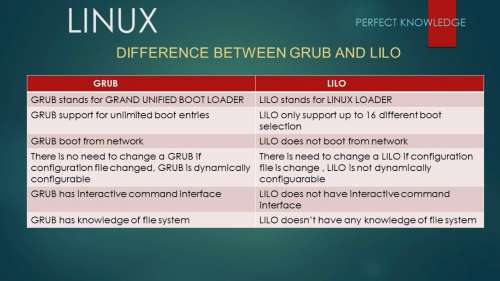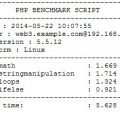LILO (Linux Loader) and GRUB (GRand Unified Bootloader) are both configured as a primary boot loader (installed on the MBR) or secondary boot loader (installed onto a bootable partition).
First question, what is a boot loader.
The simple answer: a boot loader loads the operating system.
When your machine loads its operating system, the BIOS reads the first 512 bytes of your bootable media (which is known as the master boot record, or MBR). For more information of MBR, see MBR at Wikipedia.
LInux LOader, or LILO, comes as standard on all distributions of Linux. As one of the older/oldest Linux boot loaders, its continued strong Linux community support has enabled it to evolve over time and stay viable as a usable modern-day boot loader. Some new functionality includes an enhanced user interface and exploitation of new BIOS functions that eliminate the old 1024-cylinder limit.
Lilo configuration file is located at /etc/lilo.conf
Here is an example:
boot=/dev/hda map=/boot/map install=/boot/boot.b prompt timeout=100 compact default=Linux image=/boot/vmlinuz-2.4.18-14 label=Linux root=/dev/hdb3 read-only password=linux other=/dev/hda label=WindowsXP
Since lilo.conf is not read at boot time, the MBR needs to be “refreshed” when this is changed. If you do not do this upon rebooting, none of your changes to lilo.conf will be reflected at startup. Like getting LILO into the MBR in the first place, you need to run:
$ /sbin/lilo -v -v
More recently, the GRand Unified Boot loader (commonly known as GRUB) seems to have somewhat taken the boot loaders crown from LILO. GNU GRUB is actively developed by the Free Software Foundation and based on the original GRUB program, originally created by Erich Stefan Boleyn.
GRUB configuration file is located at /boot/grub/grub.conf
Here is an example of it:
default=0 timeout=10 splashimage=(hd1,2)/grub/splash.xpm.gz password --md5 $1$opeVt0$Y.br.18LyAasRsGdSKLYlp1 title Red Hat Linux password --md5 $1$0peVt0$Y.br.18LyAasRsGdSKLYlp1 root (hd1,2) kernel /vmlinuz-2.4.18-14 ro root=LABEL=/ initrd /initrd-2.4.18-14.img title Windows XP password --md5 $1$0peVt0$Y.br.18LyAasRsGdSKLYlp1 rootnoverify (hd0,0) chainloader +1
Unlike LILO’s configuration file, grub.conf is read at boot time, and the MBR does not need to be refreshed when this is changed.
Let us see the difference
GRUB vs. LILO
As stated at the start of this article, all boot loaders work in a similar way to fulfill a common purpose. But LILO and GRUB do have a number of differences:
LILO has no interactive command interface, whereas GRUB does.
LILO does not support booting from a network, whereas GRUB does.
LILO stores information regarding the location of the operating systems it can to load physically on the MBR. If you change your LILO config file, you have to rewrite the LILO stage one boot loader to the MBR. Compared with GRUB, this is a much more risky option since a misconfigured MBR could leave the system unbootable. With GRUB, if the configuration file is configured incorrectly, it will simply default to the GRUB command-line interface.
Most of this post via here.




